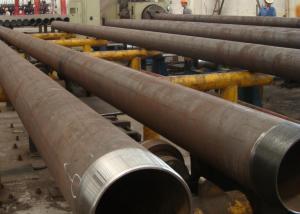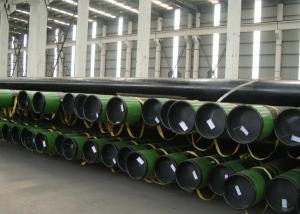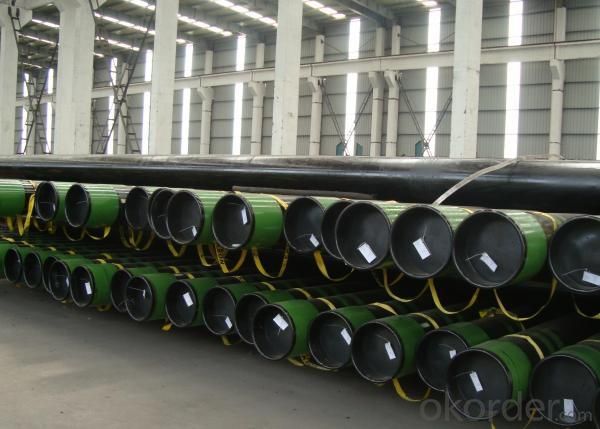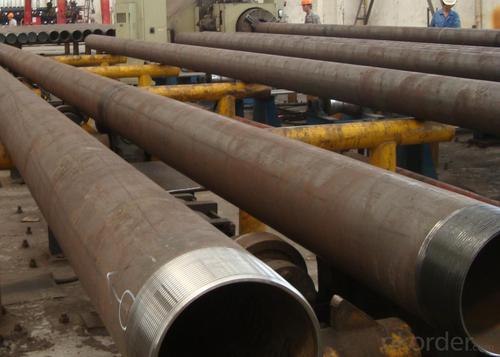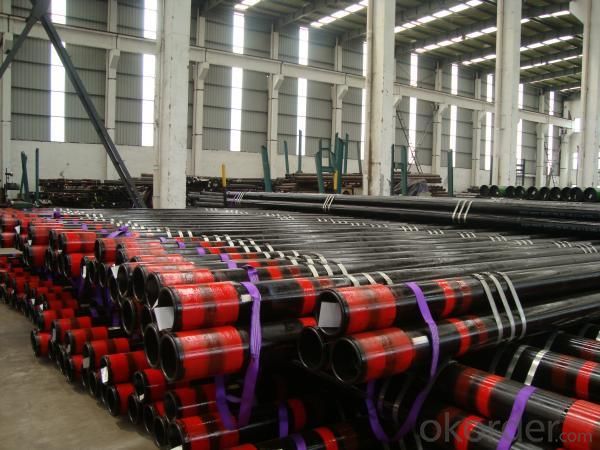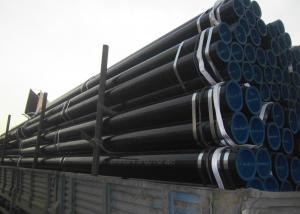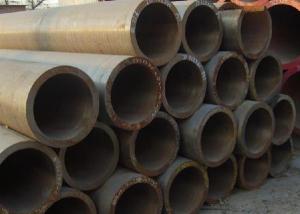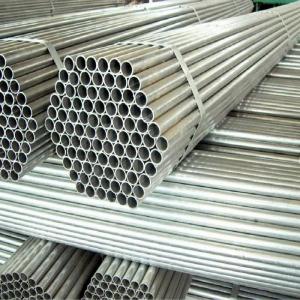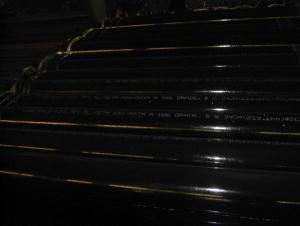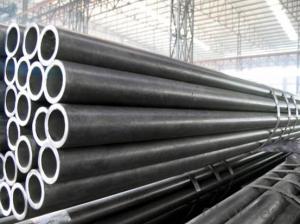BS 1387 Oil Casing and Casing Pipe APL SPEC 5CT Low Tolerance Best Quality BS Standard
- Loading Port:
- China Main Port
- Payment Terms:
- TT or LC
- Min Order Qty:
- 25 M.T. m.t.
- Supply Capability:
- 5000 Tons Per Month m.t./month
OKorder Service Pledge
OKorder Financial Service
You Might Also Like
Standard: APL SPEC 5CT
Tolerance
Item | Tolerance | |
Outside Diameter |
Pipe Body | D≤101.60mm±0.79mm |
D≥114.30mm +1.0%D-.5%D | ||
coupling | ±1%D | |
Wall Thickness | 0,-12.5%t | |
Weight | Single Lengths | +6.5%-3.5% |
Carload Lots | 0,-1.75% | |
Length
| (Range 1) | (Pange 2) | (Pange 3) |
Tubing | 6.10-7.32m | 8.53-9.75m | 11.58-12.80m |
Casing | 4.88-7.62m | 7.62-10.36m | 10.36-14.63m |
Pup Joint | 0.5m-6.0m(2FEET-20FEET) | ||
Mechanical Properties:
Group | Grade | Yield Strength | Tensile Strength | Hardness | Allowable Hardness Variation | |||||
min | max | min | max | |||||||
Psi | Mpa | Psi | Mpa | Psi | Mpa | HRC | BHN | HRC | ||
1 | J55 | 55,000 | 379 | 80,000 | 552 | 75,000 | 517 | - | - | - |
K55 | 55,000 | 379 | 80,000 | 552 | 95,000 | 655 | - | - | - | |
N80-1 | 80,000 | 552 | 80,000 | 758 | 100,000 | 689 | - | - | - | |
N80Q | 80,000 | 552 | 80,000 | 758 | 100,000 | 689 |
|
| - | |
2 | M65 | 65,000 | 448 | 85,000 | 586 | 85,000 | 586 | 22 | 235 | - |
L80-1 | 80,000 | 552 | 95,000 | 655 | 95,000 | 655 | 23 | 241 | - | |
C90-1 | 90,000 | 621 | 105,000 | 724 | 100,000 | 689 | 25.4 | 255 | 3.0 | |
C90-2 | 90,000 | 621 | 105,000 | 724 | 100,000 | 689 | 25.4 | 255 | 3.0 | |
C95 | 95,000 | 655 | 110,000 | 758 | 105,000 | 724 | - | - | - | |
T95-1 | 95,000 | 655 | 110,000 | 758 | 105,000 | 724 | 25.4 | 255 | 3.0 | |
T95-2 | 95,000 | 655 | 110,000 | 758 | 105,000 | 724 | 25.4 | 255 | 3.0 | |
3 | P110 | 110,000 | 758 | 140,000 | 965 | 125,000 | 862 | - | - | - |
Chemical Composition (%)
Grade | Chemical Composition% | ||||||||||||
C | Mn | Mo | Cr | Nl | Cu | P | S | Si | |||||
min | max | min | max | min | max | min | max | max | max | max | max | Max | |
J55 | - | - | - | - | - | - | - | - | - | - | 0.030 | 0.030 | - |
K55 | - | - | - | - | - | - | - | - | - | - | 0.030 | 0.030 | - |
N80-1 | - | - | - | - | - | - | - | - | - | - | 0.030 | 0.030 | - |
N80Q | - | - | - | - | - | - | - | - | - | - | 0.030 | 0.030 | - |
M65 | - | 0.43 | - | 1.90 | - | - | - | - | 0.25 | 0.35 | 0.030 | 0.030 | 0.45 |
L80-1 | - | 0.35 | - | 1.00 | 0.25 | 0.75 | - | 1.2 | 0.99 | - | 0.020 | 0.010 | - |
C90-1 | - | 0.50 | - | 1.90 | - | NL | - | NL | 0.99 | - | 0.030 | 0.010 | - |
C90-2 | - | 0.45 | - | 1.90 | - | - | - | - | - | - | 0.030 | 0.030 | 0.45 |
C95 | - | 0.35 | - | 1.20 | 0.25 | 0.85 | 0.40 | 1.50 | 0.99 | - | 0.020 | 0.010 | - |
T95-1 | - | 0.50 | - | 1.90 | - | - | - | - | 0.99 | - | 0.030 | 0.010 | - |
T95-2 | - | - | - | - | - | - | - | - | - | - | - | 0.030 | 0.45 |
P110 | - | - | - | - | - | - | - | - | - | - | - | 0.030 | 0.45 |
Available sizes
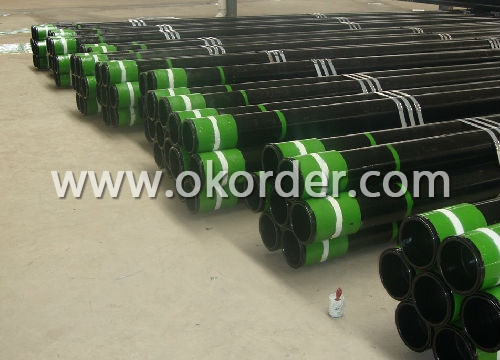
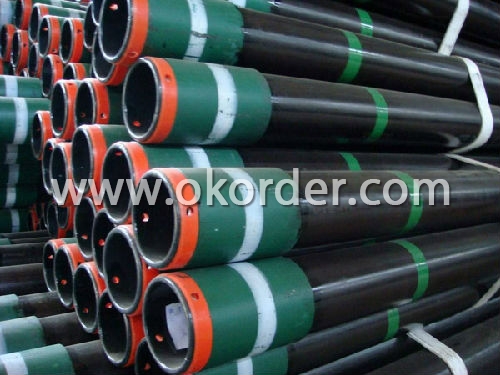
- Q: How are steel pipes used in the manufacturing of aerospace components?
- Steel pipes are commonly used in the manufacturing of aerospace components for various purposes such as fuel and hydraulic systems, structural supports, and exhaust systems. These pipes provide strength, durability, and resistance to high temperatures and pressure, making them suitable for critical applications in the aerospace industry.
- Q: Can steel pipes be used for solar power systems?
- Indeed, solar power systems can utilize steel pipes. In the realm of solar power systems, steel pipes find widespread usage in diverse applications such as constructing support structures, mounting systems, and piping systems for circulating heat transfer fluids. The reason behind the preference for steel pipes lies in their robustness, longevity, and ability to withstand various environmental conditions. These pipes possess the capability to bear the weight of solar panels and support structures, as well as endure the impact of wind and other external elements. Moreover, steel pipes can be easily tailored and welded to cater to specific project requirements. All in all, when it comes to solar power systems, steel pipes emerge as a dependable and cost-efficient alternative.
- Q: Can steel pipes be used for transporting drinking water?
- Yes, steel pipes can be used for transporting drinking water. Steel pipes are commonly used in water distribution systems and have been used for many years. They are known for their durability, strength, and resistance to corrosion. However, it is important to ensure that the steel pipes used for transporting drinking water are properly coated or lined to prevent any potential contamination from the metal. Additionally, regular inspections and maintenance should be carried out to ensure the integrity of the pipes and to prevent any leaks or breaks that could compromise the quality of the water.
- Q: Difference between seamless steel pipe and welded pipe
- Welded steel pipe for different welding process and divided into the furnace pipe welding (ERW) pipe and automatic arc welding, because of the different forms of welding seam welded pipe and spiral welded pipe is divided into two kinds, end its shape is divided into circular welded and shaped (square) pipe etc..
- Q: What are the different types of fittings used with steel pipes?
- Steel pipes are commonly paired with various fittings that serve to connect, control, or alter the flow direction in a piping system. Some of these fittings include: 1. Elbow fittings: Designed to modify the flow direction, elbow fittings are available in different angles, such as 45 or 90 degrees. They are frequently utilized to navigate obstacles or introduce bends in the pipe. 2. Tee fittings: Tee fittings are implemented to create a branch or division in the piping system. With three openings, one perpendicular to the other two, they enable the connection of two pipes at a 90-degree angle. 3. Coupling fittings: Used to join two pipes of the same size, coupling fittings are typically threaded and can be easily fastened or removed with a wrench. They are commonly employed when pipes need to be connected or repaired. 4. Reducer fittings: Reducers are employed to connect pipes of varying sizes. They consist of one end with a larger diameter and another end with a smaller diameter. Reducers are often employed to transition between pipe sizes or adapt to different equipment or fittings. 5. Flange fittings: Flanges are utilized to establish a secure and leak-proof connection between pipes, valves, or other equipment. They consist of a flat, circular plate with holes to accommodate bolts or screws for fastening the flange to the pipe. Flange fittings find frequent use in applications that necessitate frequent disassembly and reassembly. 6. Union fittings: Union fittings are employed to join two pipes in a manner that facilitates easy disconnection. They comprise three parts: a nut, a female end, and a male end. Union fittings are commonly used in scenarios that require periodic maintenance or repairs. 7. Cap fittings: Cap fittings are employed to seal the end of a pipe. Usually threaded, they can be effortlessly screwed onto the pipe's end. Cap fittings are commonly used in instances where temporary closure or protection of pipes is necessary. These examples represent some of the various fittings utilized with steel pipes. The specific fitting required depends on factors such as the application, pipe size and material, as well as the desired functionality of the piping system.
- Q: How are steel pipes used in fire protection systems?
- Fire protection systems rely on the inclusion of steel pipes, which serve as an essential component for the distribution of water and fire suppressants within buildings. These pipes are renowned for their robustness, longevity, and ability to endure extreme temperatures, rendering them optimal for withstanding the harsh conditions associated with fires. Within fire protection systems, steel pipes are commonly utilized to establish an interconnected network of pipes responsible for supplying water to sprinkler heads or fire hydrants throughout a building. This network guarantees that water is readily accessible to suppress or extinguish fires during emergencies. One of the primary advantages of steel pipes in fire protection systems is their capacity to withstand the elevated pressure and flow rates necessary for effective fire suppression. Steel pipes can handle forceful water flow with ease, enabling prompt and efficient distribution of water to affected areas, thereby aiding in the control and extinguishing of fires in the shortest possible time. Additionally, steel pipes possess an inherent resistance to corrosion, a crucial attribute for preserving the integrity of fire protection systems over time. Corrosion has the potential to weaken pipes, leading to leaks or complete failure, which can prove catastrophic during a fire incident. However, steel pipes possess an extended lifespan and require minimal maintenance when compared to other pipe materials, ensuring the longevity and dependability of the system for many years to come. Moreover, steel pipes are frequently selected for use in fire protection systems due to their fire-resistant properties. Steel inherently possesses the ability to withstand high temperatures without deformation or compromising its structural integrity. This characteristic is of utmost importance in fire protection systems, as it enables the pipes to remain intact and continue delivering water even amidst a fire, ensuring the safety of occupants and minimizing damage to the building. In conclusion, steel pipes hold a pivotal role in fire protection systems by guaranteeing the reliable and efficient distribution of water or fire suppressants. Their strength, durability, resistance to high temperatures, and corrosion resistance make them the ideal choice for effectively combating fires and safeguarding lives and property.
- Q: The difference between carbon and welded steel tubes
- Seamless steel pipe because there is no weld, so can withstand greater pressure, boiler tubes are generally used seamless steel pipe
- Q: How are steel pipes classified based on their end connections?
- Steel pipes can be classified based on their end connections into threaded, socket weld, butt weld, and flanged connections.
- Q: How are steel pipes used in the construction of stadiums and arenas?
- Steel pipes are commonly used in the construction of stadiums and arenas for various purposes. They are primarily used for structural support, providing a sturdy framework for the buildings. Steel pipes are also used in the installation of plumbing systems, helping to transport water and other fluids throughout the facility. Additionally, steel pipes are utilized for the construction of ventilation and HVAC systems, ensuring proper air circulation and temperature control within the stadiums and arenas.
- Q: How does the price of steel pipes fluctuate?
- The price of steel pipes fluctuates based on several factors including demand and supply dynamics, raw material costs, global economic conditions, and government policies. Changes in demand from industries such as construction, oil and gas, and manufacturing can impact the price of steel pipes. Additionally, fluctuations in the cost of raw materials like iron ore and steel scrap can influence the price. Global economic conditions and trade policies can also play a role in determining the price of steel pipes, as they affect international trade and supply chains. Overall, the price of steel pipes is subject to market forces and can vary over time.
1. Manufacturer Overview
| Location | Shanghai China |
| Year Established | 1999 |
| Annual Output Value | Above Thirty Million RMB |
| Main Markets | Main land;Middle East; Southeast Asia |
| Company Certifications | ISO 9001:2010;API 5L |
2. Manufacturer Certificates
| a) Certification Name | |
| Range | |
| Reference | |
| Validity Period |
3. Manufacturer Capability
| a) Trade Capacity | |
| Nearest Port | Baoshan |
| Export Percentage | 41% - 50% |
| No.of Employees in Trade Department | 300-500 People |
| Language Spoken: | English; Chinese |
| b) Factory Information | |
| Factory Size: | 30,000 square meters |
| No. of Production Lines | Above 10 |
| Contract Manufacturing | OEM Service Offered; Design Service Offered |
| Product Price Range | Average |
Send your message to us
BS 1387 Oil Casing and Casing Pipe APL SPEC 5CT Low Tolerance Best Quality BS Standard
- Loading Port:
- China Main Port
- Payment Terms:
- TT or LC
- Min Order Qty:
- 25 M.T. m.t.
- Supply Capability:
- 5000 Tons Per Month m.t./month
OKorder Service Pledge
OKorder Financial Service
Similar products
Hot products
Hot Searches
Related keywords
